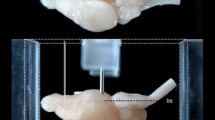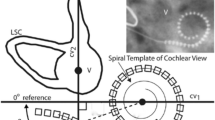Summary
All attempts to reconstruct the topography of the brain in the living from studies of animal material are handicapped by technical difficulties. The best method is to compare exact X-ray pictures, which have been taken under stereotactic conditions. From a large collection of such X-rays the authors have composed contours of the internal table of the skull and of the ventricles, which best match the brains, selected for the Schaltenbrand-Bailey stereotactic atlas. For practical purposes these contours were combined with the transparent overlays for the nomenclature and the border lines of the different parts of the basal ganglia, which have been used in the myelin sections part of the atlas. A comparison of our sagittal series with the new X-ray findings shows, that the sagittal schemata of the atlas represent an extreme variation in the position of the Meynert axis and of the contours of the 4th ventricle. We have chosen a new axis system for the hindbrain, which corresponds to the average of our brains in constructing a new set of typical overlays for the atlas. The contour of the posterior fossa had to be completed. An independent axis system for the structures of the 4th ventricle was developed, consisting of the base of the 4th ventricle, and a tangent, to the upper contour of the pons. In stereotactic procedures the axis systems for the forebrain and the hindbrain should be used independently. The results obtained are the basis for a new series of lantern slides which can be projected against the X-ray pictures with the Würzburg stereotactic equipment.
In the course of this investigation we discovered a source of error. When air enters the puncture hole of the dura, the brain may sink back, so with the patient lying on his back, all structures may shift a few millimeters towards the occipital region. When the patient is lying on his side, as during an approach to the amygdala through the planum temporale, the ventricular system may collapse, so that almost no air is visible in the ventricles and the 3rd ventricle may appear to be in the lower hemisphere, the dislocation being more than 5–8 mm. But filling the ventricle with air through the ventricular catheter is sufficient to blow up the brain and to restore the normal topography.
Zusammenfassung
Alle Versuche, die Topographie des Gehirns des lebenden Menschen aus anatomischem Material zu rekonstruieren, werden durch technische Schwierigkeiten beeinträchtigt. Das beste Verfahren ist der Vergleich genauer Röntgenaufnahmen, die unter stereotaktischen Bedingungen aufgenommen worden sind. Aus einer großen Sammlung solcher Röntgenaufnahmen haben die Verfasser die Konturen der Tabula interna des Schädels und der Ventrikel nachgezeichnet und diejenigen ausgesucht, die am besten zu dem Schaltenbrand-Baileyschen stereotaktischen Atlas passen. Für den praktischen Gebrauch werden die so gewonnenen Umrißzeichnungen mit den Negativen der durchsichtigen Deckblätter kombiniert, die auf den vierfach vergrößerten Markscheidenserien des Bandes II des Atlasses befestigt sind und auf denen die Felderung und die Bezeichnungen der einzelnen Strukturen des Gehirns verzeichnet wurden. Ein Vergleich unserer Sagittalserie mit den neuen röntgenologischen Befunden zeigt eine extreme Variation in der Stellung der Meynertschen Ebene zum Achsensystem des Großhirns. Wir haben deswegen ein neues Achsensystem für den 4. Ventrikel aus den Kurvenscharen unserer Zeichnungen herausgesucht, um neue bewegliche Deckblätter für die Ventrikelkonturen des Atlasses zu gewinnen. Als Grundlage für das Achsensystem haben wir die Basis des 4. Ventrikels und eine Senkrechte, welche den oberen Brückenrand tangiert, gewählt. Weil der Winkel zwischen dem CA-CP-Achsensystem und dem Achsensystem des 4. Ventrikels von Patient zu Patient variiert, sollten diese beiden Achsensysteme bei der Bestimmung der Koordinaten von Zielpunkten getrennt benutzt werden. Die Parameter der Kleinhirngebiete sollten unabhängig von dem Zentimeternetz für den Hirnstamm gewonnen werden, da diese eine stärkere Beziehung zum Fastigium des 4. Ventrikels haben. Die so gewonnenen Unterlagen können zur Herstellung neuer Diapositivserien für die in Würzburg verwandte Gegenprojektionsmethode benutzt werden.
Im Laufe der Untersuchungen entdeckten wir eine Fehlerquelle: Wenn Luft durch das Punktionsloch in den Subduralraum eindringt, sinkt das Gehirn nach der unten liegenden Seite ab. Dies ist besonders störend, wenn bei Eingriffen im Schläfenlappen beim seitlich liegenden Patienten die Ventrikel kollabieren und nach unten absinken. Der Fehler kann aber leicht durch Aufblähung des Ventrikelsystems mit Luft beseitigt werden.
Similar content being viewed by others
Literatur
Amador, J., Blundell, E., Wahren, R.: Beschreibung der Koordinaten der tiefen Struktur. Aus: Einführung in die stereotaktischen Operationen mit einem Atlas des menschlichen Gehirns, G. Schaltenbrand, P. Bailey, Hrsg. Stuttgart: Thieme 1959
Bertrand, G., Olivier, A., Thompson, C. J.: Computer display of stereotaxic brain maps and probe tracts. Acta neurochir. (Wien), Suppl. 21, 235–243 (1974)
Delmas, A., Pertuisset, B.: La topometrie cranioencéphalographie. Paris: Masson 1959
Gerdes, F. U.: Röntgenanatomische Untersuchungen am Lebenden über die Topographie von Schädel und Liquorräumen im Frontalbild. Dissertation, Würzburg 1974
Gortvai, P., Teruchkin, S.: The position and extend of the human dentate nucleus. Acta Neurochir. (Wien), Suppl: 21, 101–110 (1974)
Horsley, V., Clarke, R.: Brain 31, 45–124 (1908)
Klein, G. W.: Röntgenanatomische Untersuchungen am Lebenden über die Topographie von Schädel- und Liquorräumen im Seitenbild. Dissertation, Würzburg 1973
Nadjmi, M., Schaltenbrand, G., Wahren, W.: Die vordere Kommissur und ihre anatomischen Variationen im Interkommissuralsystem. Radiologe 6, 12 (1966)
Nadjmi, M.: Form und Lagevariationen des Aquädukts und der caudalen Anteile des 3. Ventrikels im positiven Ventrikulogramm. Radiologe 7, 375–377 (1968)
Nürnberger, S., Schaltenbrand, G.: Röntgenologische Orientierungsmerkmale für stereotaktische Eingriffe. Aus: Einführung in die stereotaktischen Operationen mit einem Atlas des menschlichen Gehirns. Stuttgart: Thieme 1959
Spiegel, E., Wycis, H.: Stereoencephalotomy, Part I. New York: Grune & Stratton 1952
Talairach, J.: Atlas d'anatomic stereotaxic. Paris: Masson & Cie 1957
Author information
Authors and Affiliations
Rights and permissions
About this article
Cite this article
Gerdes, F.U., Klein, G., Nadjmi, M. et al. Die stereotaktische Orientierung im menschlichen Hirn an Hand röntgenologischer Befunde. J. Neurol. 210, 183–190 (1975). https://doi.org/10.1007/BF00316245
Received:
Issue Date:
DOI: https://doi.org/10.1007/BF00316245




